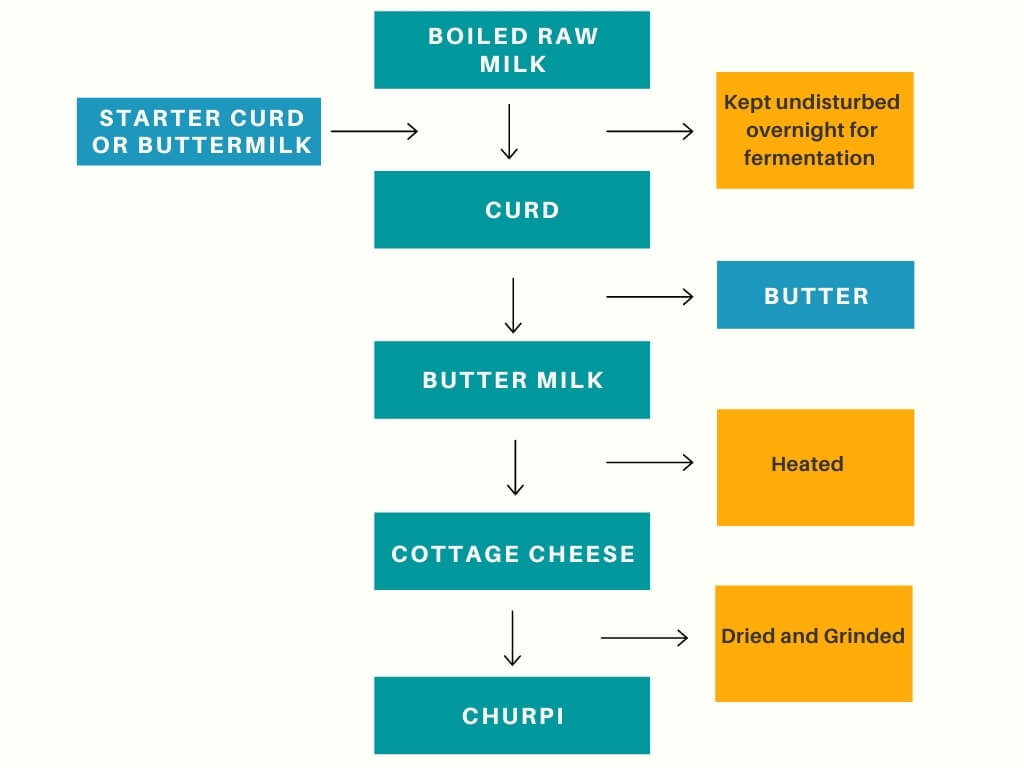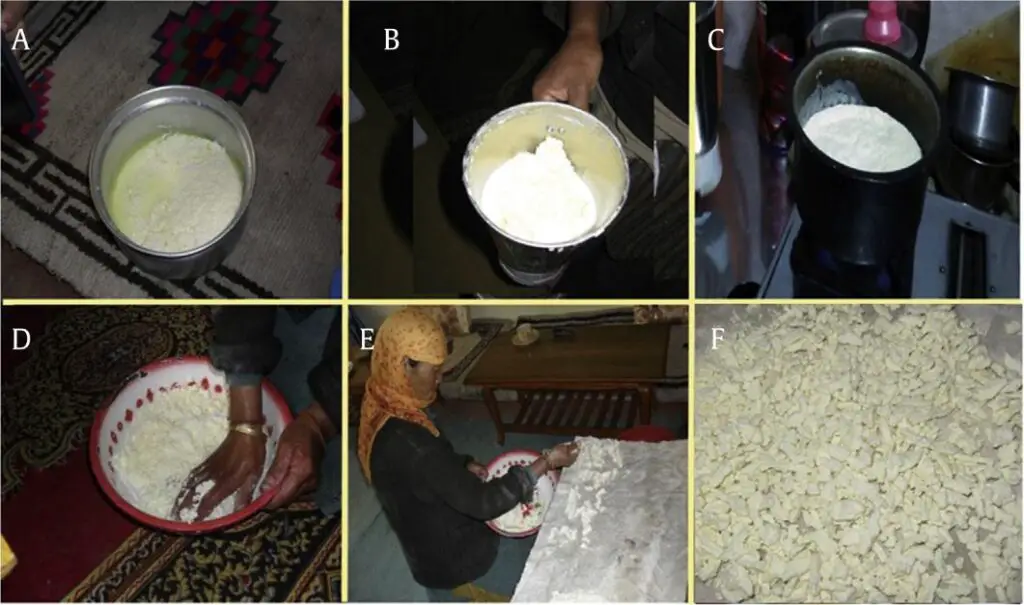Introduction to churpi / churpy / chhurpi cheese
The curpi cheese is one of the traditional varieties of fermented dairy products made from cow or yak milk and consumed by various ethnic groups living in the northern highland regions of India and Nepal. This cheese is one of the oldest (and probably the hardest) and most primitive cheeses in the world.
These northern regions undergo severe winters because of which the farmers from these alpine regions process milk from cows or yak to produce various traditional milk products such as curd, butter and cheese (churpi / churpy). This enables them to store protein for longer period of time.
Milk products like churpi cheese is one of the main source of daily diet and a vital element of good health. Historically, longer shelf life milk product such as churpi has also enabled populations in these cold regions to survive periodic famines.
The residents of these mountainous areas chew this every day to get through the biting low temperatures. Furthermore, it helps in removing plaque and tartar and maintain healthy gums. Churpi cheese also has a remarkable reservoir of ‘natural’ microbes and can be used as a good probiotic.
Both cow and yak milk can be used to prepare Churpi, but cow milk Churpi has a softer texture and a milder taste than yak milk Churpi, and it is used in curry mixes, pickles and condiments.
In modern times, churpi cheese has now come into the mainstream. Churpi, a residue-free product, is now in high demand and fetches handsome prices in the local market. Now, Churpi cheese is not just produced in the farmers household but also entered into the upcoming agribusiness market.
How is Churpi cheese made ?
Making chrupi cheese is relatively simple compared to making most western cheeses.

Step 1. Raw milk
The raw milk is boiled. Boiling time is determined by the quantity of milk. In order to form curd, boiled milk is inoculated with some starter culture, such as curd (dahi, jho in local language) or buttermilk, and kept undisturbed for a few hours (preferably overnight) in a warm place for fermentation.
The proportion of milk to starter culture is 3:1 or 2:1. You can use any proportion and with experience, you will have the appropriate ratio that works for you.
Step 2. Curd
Incubated milk, or curd, is transferred to a churner after incubation. It is then churned in a large vessel until the separation of butter (marr in local language) from butter milk (tara or tharara in local language) is visible. Occasionally, warm water is also added for better separation. The buttermilk is then used to make cottage cheese.

Step 3. Butter milk
Buttermilk is then heated to its boiling point, and the heating is continued until coagulation is satisfactory. Then it is allowed to cool for a few minutes. The cooling process helps separate the solid particles, i.e. cottage cheese, from the liquid part, i.e. whey (also known as chhurkhu in local terminology).
Step 4. Cottage Cheese
The cottage cheese (soft churpi) obtained from the above process is wrapped in a cloth and hung to remove excess moisture. The moisture content of this cottage cheese is about 78.3 percent. This moisture reduces the shelf life of the cheese and has to be removed to greater shelf life.
Step 5. Churpi cheese
Churpi cheese is dried cottage cheese. To increase its storability, the cottage cheese is divided into small round loaves of irregular shape and size and traditionally it is dried directly under sunlight for one day over the roof in order to reduce its moisture content.
Solar dryers are now also used in order to dry this indigenous product. Churpy can be preserved in this way for many years; the more ripened it becomes the more valuable it becomes.

Nutrient content of churpi cheese
Churpi cheese has a relatively low moisture content, a low fat content, and a high protein content.
| Parameters | Soft churpi | Hard churpi |
|---|---|---|
| pH | 4.89 ± 0.01 | 4.32 ± 0.02 |
| Titratable acidity (%) | 0.32 ± 0.02 | 0.51 ± 0.05 |
| Total solid (%) | 29.8 ± 1.12 | 89.77 ± 1.61 |
| Moisture (% wt) | 72.62 ± 1.88 | 10.22 ± 2.02 |
| Protein (% DM) | 60.78 ± 0.66 | 63.33 ± 0.47 |
| Fat (% DM) | 8.8 ± 0.18 | 7.2 ± 0.32 |
| Ash (% DM) | 5.9 ± 1.65 | 6.3 ± 1.08 |
| Carbohydrate (% DM) | 24.52 ± 1.74 | 23.17 ± 2.11 |
| Lactic acid (mg/g) | 0.12 ± 0.88 | 0.23 ± 0.73 |
| Acetic acid (mg/g) | 0.06 ± 1.18 | 0.16 ± 1.32 |
| Riboflavin (mg/g) | 162.71 ± 1.06 | 102.22 ± 1.30 |
| Thiamine (mg/g) | 64.48 ± 1.22 | 35.6 ± 1.11 |
| Vitamin C (mg/g) | 23.53 ± 0.93 | 9.86 ± 0.69 |
| Ethanol (%) | 0.006 ± 0.001 | 0.01 ± 0.005 |
| Methanol (%) | 0.002 ± 0.001 | 0.004 ± 0.021 |
DM, dry matter; % DM, g/100 g dry matter.
Source : Journal of Ethnic Foods · December 2016 Author: Kuntal Ghosh, Sourav Kumar Nandi, Debabrata Bera
Characteristics of churpi cheese
- Taste of Churpi cheese : Slightly sour
- Colour of Churpi cheese : White to orange
- Consistency of Churpi cheese : Very Hard
- Storage quality of churpi cheese : very good
- Appearance of churpi cheese : Uneven texture and surface
- Butter milk required to make 1 KG of churpi cheese : 8 – 10 kg butter milk
Conclusion
Due to a lack of fruits and vegetables, limited food resources, unavailability of soil due to snow cover, as well as the closure of roads in winter in these areas, milk products like churpi are essential sources of vitamins and nutrients. Traditionally, the people of the region have developed a unique method of milk processing.
Though the popularization of churpi cheese is on a rise, there is still a huge gap for it to become on of the mainstream milk processing agribusiness.

